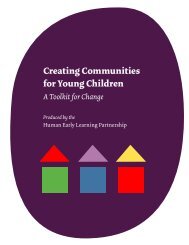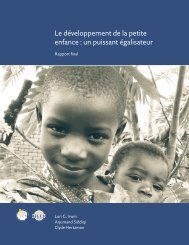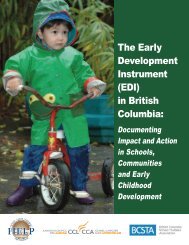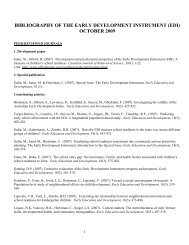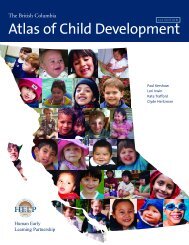Total Environment Assessment Model for Early Child Development
Total Environment Assessment Model for Early Child Development
Total Environment Assessment Model for Early Child Development
Create successful ePaper yourself
Turn your PDF publications into a flip-book with our unique Google optimized e-Paper software.
Spheres of<br />
Influence:<br />
The Family<br />
of attachment to a primary caregiver, prior<br />
research has shown that there are differences<br />
in the physiological and functional developmental<br />
outcomes of children reared longer<br />
in orphanages, versus those who are adopted<br />
early. These studies suggest that children who<br />
are adopted early show much lower cortisol<br />
levels and much fewer behavioral difficulties<br />
than those children who remain in orphanages<br />
<strong>for</strong> longer [3 4].<br />
Beyond observational data, there has been<br />
a randomized control trial study that demonstrated<br />
an independent effect (over and above<br />
nutritional supplementation) of stimulation<br />
(as operationalized by mothers and children<br />
playing with homemade toys) on perceptual<br />
motor development outcomes among stunted<br />
children [3]. Attachment is associated with<br />
quality internal fantasy lives, flexibility and<br />
complexity of play, and greater emotional<br />
range [35]<br />
Findings regarding the importance<br />
of primary caregivers (and by extension,<br />
families) <strong>for</strong> children, has led to the exploration<br />
of the factors that facilitate healthy social<br />
bonds and caregiving practices. All families<br />
need some support to learn how to develop<br />
and apply sensitivity and responsiveness in<br />
their childcare practices. There are, however,<br />
both biological and environmental factors<br />
that can negatively impact on attachment.<br />
These include low birth weight, malnutrition<br />
and infections, poverty and its associations,<br />
conflict and domestic violence, and mental<br />
health problems such as maternal depression.<br />
In these instances, external support <strong>for</strong><br />
families is particularly important.<br />
family socioeconomic status<br />
Family socioeconomic circumstances have<br />
been a major area of study in this regard. What<br />
is noteworthy here is that, though ‘poverty’<br />
(as generally measured by some monetary<br />
threshold) poses a significant barrier, healthy<br />
bonding, caregiving, and ultimately ecd<br />
outcomes, are not solely limited to those<br />
falling below the threshold. Rather, degrees<br />
of change in resources throughout the<br />
socioeconomic spectrum results in degrees of<br />
change in ecd.<br />
This pattern of an incremental, linear<br />
relationship between socioeconomic status<br />
and human development in a population<br />
is referred to as a socioeconomic gradient<br />
(further explanation of socioeconomic status<br />
(ses) gradients is provided later in this<br />
chapter). Socioeconomic gradients suggest<br />
strongly that, in contrast to strategies which<br />
attend only to those below the poverty<br />
threshold, a society-wide approach much be<br />
applied in order to truly address the association<br />
between socioeconomic conditions and<br />
ecd, a point to which we return later.<br />
Ample evidence suggests that family (ses)<br />
is associated with a myriad of development<br />
outcomes <strong>for</strong> children all across the world<br />
[36-38]. In particular, there is a rich literature<br />
on the tremendous influence of maternal<br />
education on providing children with<br />
stimulating and supportive, and nurturant<br />
environments <strong>for</strong> children [39-42]. Further,<br />
the literature suggests strongly that socioeconomic<br />
gradients in early childhood replicate<br />
themselves as socioeconomic gradients<br />
throughout the human lifecourse [11].<br />
A review of the outcomes associated with<br />
family ses are extremely diverse, ranging<br />
from increased probability of having low<br />
birth-weight (itself associated with a host<br />
of developmental difficulties later in life),<br />
to risk of dental carries, to poorer cognitive<br />
test scores, to difficulties with behavior<br />
and socialization, and to increased odds of<br />
disengagement from school [36, 43].<br />
Social and economic resources are<br />
significant <strong>for</strong> ecd and related outcomes <strong>for</strong><br />
several reasons. For instance, low levels of<br />
education and literacy affect the knowledge<br />
and skill-base of children’s caregivers; feeding<br />
and breastfeeding practices (which in turn<br />
affect childhood stunting and wasting or<br />
obesity) vary by ses. From an environmental<br />
perspective, there are two major reasons<br />
that socioeconomic conditions matter. First,<br />
children born poorer are more likely to be<br />
exposed to conditions that are adverse <strong>for</strong><br />
development (e.g. crowded or slum living<br />
conditions, unsafe neighborhoods, etc).<br />
Second, studies have shown that poorer<br />
children are also more likely to be affected<br />
by adverse conditions, resulting in a ‘double<br />
jeopardy’ of sorts [17].<br />
30



